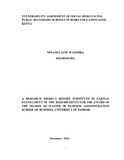| dc.description.abstract | Vulnerability to social risks has been a matter of increasing concern in secondary schools
in Kenya today. A comprehensive school security review is an essential step when
addressing the security needs of one’s school. Such a review should not be a one off
activity; instead, it should be part of an on-going monitoring plan. This ensures that one
keeps on top of any issues that need addressing and monitor how they progress. Some of
the risks facing schools are fire breakouts, theft and burglary. Other risks involve the
infrastructural layout of the schools with most schools having no exit doors or the
emergency doors .Also, there are substandard infrastructure e.g. weak doors, pane less
windows, lack of gates and other basic amenities. These may be among the other risks
that a school may be exposed to. Though these risks may not be underrated, the Ministry
of Education has made an effort to mitigate losses in the occurrence of such risks. But of
concern in this study is the assessment of vulnerability to social risks that students in the
secondary schools are exposed to. Various incidents have been reported on exposures
that students are vulnerable to. A good example is the recent special report that disclosed
that girls and boys as young as 13 years were actively engaged in sex with multiple
partners. The report indicates that four in every ten youth between 13 and 19 had engaged
in sex (Daily Nation, June, 2013). The study hoped to bring to the fore the extent and
level of vulnerability students are exposed to. It also investigated whether or not any
assessment had been made and hopefully what risk mitigation measures had been
identified and applied as far as the social risks are concerned. In order to capture the data,
school visits were conducted in order to get the information first-hand. Other methods
towards data collection included assessment of records especially information relating to
students which was taken from the schools records which include the class registers, log
books, guidance and counseling records, from Ministry of Education (MOE) and Nongovernmental
Organizations (NGOs) that are based in the region. Further, information
was obtained by conducting interviews with the parties of interest such as the students,
teachers and stakeholders in the community. Use of guided questionnaires was
administered to the principals, guidance and counseling mistresses and the school
captains. Interviews and discussions were done to such respondents as the area chief, the
Officer Commanding Station (OCS) Ruiru and the Ruiru Education zone Quality
Assurance Officer (DQASO).The research was both qualitative and quantitative in
approach which allowed as much information as possible to be collected. After the
research, it was discovered that the students in Ruiru education zone are faced with such
risks as drugs use, lack of school fees, general truancy, poverty and of very great effect is
parental negligence which formed the basis of all other risks. Over 90% of the
respondents quoted this to be of very great concern. | en |

